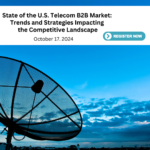Nokia’s Fixed Networks Unit Poised for Long-term Growth Despite Market Challenges
TBR Perspective: Nokia’s Fixed Networks Business Unit
Nokia is the largest vendor of fixed network access infrastructure by revenue in the Western economic bloc, a position of strength that exposes the vendor to a range of opportunities that arise in the market. While Nokia remains focused on its fiber-based platform, the vendor is also supporting fixed-wireless access (FWA), which is a rapidly growing service offering in the telecom industry.
Though revenue in Nokia’s Fixed Networks business unit has been uneven over the past few years (primarily due to the disruptions caused by the COVID-19 pandemic), the unit is poised to be one of the biggest beneficiaries of government-supported broadband programs and ongoing internet service provider (ISP) investment in high-speed broadband access technologies, driving a positive revenue trend over at least the next three to five years.
Nokia is focused on expanding access to broadband (through fiber and/or FWA) and introducing a future-proof platform for ISPs to build upon. The company is trying to be everything to everyone in this domain by providing a near complete portfolio (only DOCSIS is missing).
Despite Nokia’s favorable market position and government-induced tailwinds for the broadband infrastructure domain, TBR notes that the supply-and-demand dynamics as well as the timing of investments are prone to be disjointed, lengthening the time required to meet infrastructure deployment objectives compared to what was originally expected by the government and the telecom industry.
Additionally, TBR remains steadfast in its belief that building fiber out to every household is not economically feasible (despite what the government and stakeholders in the market say they want) and that alternative broadband access technologies (such as FWA and satellite) are going to increase in the global mix to connect the unconnected and underserved peoples of the world.
Impact and Opportunities for Nokia
BEAD Program Will Likely Stretch to the Mid-2030s due to Challenges and Delays
Broadband Equity, Access, and Deployment (BEAD) Program-supported projects are now slated to begin deployments in 2025, more than a year later than originally planned. There is a long list of reasons (most of which are related to mapping integrity and political processes) why the program has been delayed thus far, and there is a growing list of reasons that suggest it will take longer for the program to fully ramp up and complete its objective (i.e., spend all of the $42.5 billion allocated to the program).
Among the biggest challenges that lie ahead for the BEAD Program is a shortage of skilled labor (e.g., fiber splicers and trenching machine operators) and industrial equipment, such as boring machines, that will be required to deploy fiber to an estimated 5.5 million households across the U.S. Shortages of products that meet the Build America Buy America (BABA) requirements associated with the BEAD Program could also cause a timing and supply issue.
Taken together, TBR now believes the deployments tied to the BEAD Program will begin next year and it could take as long as the mid-2030s for all the program’s funding to be disbursed, more than five years longer than the government and market ecosystem originally anticipated. Nokia is doing as much as it can to mitigate and alleviate these potential challenges in the market.
For example, Nokia is proactively educating stakeholders in the ecosystem and working with its partners to better match supply with demand for products and resources. This orchestration of the ecosystem will help align stakeholders and enable the industry to put its best foot forward in carrying out this infrastructure build-out program as well as position Nokia to maintain and grow its leading share in the broadband infrastructure market.
Do Not Forget About Non-BEAD Government Programs for Broadband
Though the telecom industry likes to focus on the BEAD Program (likely because it is the largest program by dollar amount in the broadband ecosystem in the U.S. market), there are a variety of other government-supported programs that also deal with broadband, including the American Rescue Plan Act (ARPA), the Rural Digital Opportunity Fund (RDOF), the U.S. Department of the Treasury’s Capital Projects Fund, the Tribal Broadband Connectivity Program, and the U.S. Department of Agriculture’s ReConnect Loan and Grant Program.
In aggregate, TBR estimates there is more than $80 billion in direct and indirect government stimulus allocated for broadband-related projects in the U.S. market alone, all of which is slated to be spent by the mid-2030s. There are also a few hundred billion dollars in aggregate in similar broadband-implicated programs in other regions, most notably in China, the European Union, the U.K. and Australia.
Fiber Access Technology Capabilities Exceed Usability, Creating a Conundrum for Vendors
Technological innovations pertaining to fiber access have become so advanced and the bandwidth available through fiber access so massive that the capabilities of the technology far exceed what most end customers could possibly need or use. This disconnect creates a conundrum for vendors such as Nokia that supply the broadband infrastructure market.
Though fiber broadband infrastructure is, and will remain, in high demand, most ISPs will be loath to adopt the most cutting-edge technologies because they far exceed what customers would need and put unnecessary additional cost burden on the operator.
There are exceptions, such as what Google Fiber and Frontier Communications are deploying (specifically 50G and 100G connections, respectively), but TBR believes most ISPs will focus on 10G or lower connections, which is more than enough bandwidth for the vast majority of households and businesses and are likely to be future-proof for many years to come.
Overbuilding and One-upmanship Risks New Price War for High-speed Internet Service
The government funding boost, coupled with technological advancements and new entrants into the ISP domain, is creating a situation that is ripe for a price war for broadband services. Specifically, many more markets across the U.S. are likely to have three or more (in some cases up to seven) providers of high-speed broadband service in a given area, including xDSL, FTTx, HFC (via DOCSIS) as well as FWA and satellite (mostly delivered via low Earth orbit [LEO] satellites).
Given that a provider typically needs to have more than 30% market share in a given area to achieve profitability in the broadband services market, an increasing number of options puts more power into the hands of end users, which historically suggests the pricing environment will be extremely competitive.
In response to the hotter competitive environment, providers that are multiservice-oriented are trying to attract and lock in market share by offering converged (aka bundled) solutions, usually giving end users a discount as an incentive to sign up and stay.
Additionally, TBR notes that ISPs are increasingly engaging in one-upmanship (which is also a symptom of the existence of too many options in a given market), meaning ISPs are marketing ever higher broadband speeds to customers to position their offerings as better than the competition while attempting to incrementally increase average revenue per user.
Though this strategy has been effective in years past, it is likely to lose efficacy after speeds surpass the level at which the benefits of faster speeds become imperceptible to end users. Therefore, in aggregate, TBR expects the pricing environment in the U.S. for broadband service to be increasingly competitive through at least the remainder of this decade.
Private Equity Comes into the Fixed Broadband Market
Private equity firms are entering the telecom infrastructure market in a big way, gobbling up assets and forging joint ventures with telcos that want to (or need to) raise capital and hedge their risks. Some private equity-sponsored entities are also now building out their own greenfield fiber-based networks (such as Brookfield Infrastructure Partners’ Intrepid Fiber Networks) and are even moving the market toward wholesale, shared and other forms of open-access models.
Though the inclusion of private equity into the broadband infrastructure domain is bringing large pools of fresh capital into the market, this trend also risks fueling overinvestment, price compression and disruption of incumbent ISPs’ business models. Regardless, expect private equity to remain attracted to assets that offer consistent cash flow over a long duration, and their inclusion in the telecom ecosystem is likely a net positive for overall market development and evolution.
Existing Government Stimulus May Still Not be Enough for FTTP; Alternatives Will Likely be Called on at Scale to Fill in the Gaps
Though governments (and most of the stakeholders in the telecom ecosystem) across the world want full fiber to each premises, this is still not economically feasible. For example, it is not uncommon for some locations in the U.S. to cost upward of $1 million per premise to connect with fiber, a price that will be politically difficult to justify and that is not supported by normal market conditions. In these extreme situations, it is highly likely that governments will allow and embrace alternatives, such as FWA and satellite-based connectivity.
TBR notes that FWA and LEO constellations can easily deliver sustained speeds in excess of 100Mbps at a fraction of what it would cost to deploy fiber to the premises (FTTP). With that said, of the estimated 5.5 million households that the government has identified as needing broadband connection in the U.S., TBR would not be surprised if up to 25% of that number of households is ultimately connected via FWA or satellite (enhancements to DOCSIS and xDSL are also potential options to close the underserved gap). In other countries, that percentage could be even higher.
New Business Models Hold Promise to Connect Low-income Households in Emerging Markets
Upstart ISPs, such as fibertime and Vulacoin in South Africa, have established innovative solutions to cost-effectively provide high-speed broadband services to low-income areas. The architecture of the network emphasizes leveraging FWA and Wi-Fi with a relatively low amount of fiber and the business model is focused on selling units of time (in minutes), which is more affordable for lower-income end users.
TBR notes this model requires scale and high time of use to achieve profitability, meaning it is best suited for dense areas, especially impoverished neighborhoods. TBR also notes that obtaining access to high-speed internet is a key avenue in which areas can strengthen their local economies and help reduce levels of poverty.
In addition to South Africa, Brazil is also exploring the use of this model. This approach is also likely to be leveraged in other parts of Africa as well as in parts of India and Southeast Asia.
Conclusion
Government and private equity involvement in the broadband market may prove to be a mixed blessing. Though there are concerning indicators suggesting there are too many broadband providers in some key markets (especially the U.S.) and that broadband access businesses are becoming overvalued, these market dynamics actually represent tailwinds for Nokia, which is best positioned to garner a disproportionate amount of investment slated for broadband infrastructure in the Western economic bloc, which includes North America, Europe, developed APAC and select developing markets such as India.
Nokia’s outsized and unique position in the broadband infrastructure ecosystem enables the company to play a key role in orchestrating partners and customers to achieve their objectives in the most optimal way possible. Fiber will remain the coveted access medium for high-speed broadband, but the world will also employ other broadband access mediums to a large extent.
New ISP and hyperscaler business models, coupled with sustained investments by incumbent ISPs and supported by government stimulus, create an environment ripe for moving the world closer to full broadband coverage for all people.



 Erdikocak, Getty Images via Canva Pro
Erdikocak, Getty Images via Canva Pro